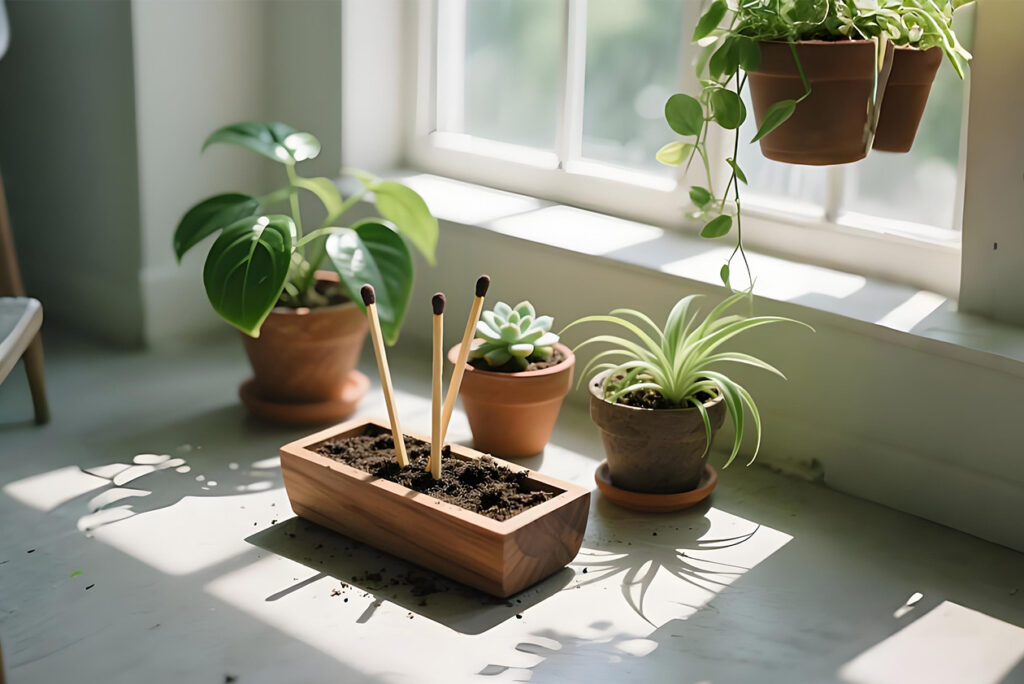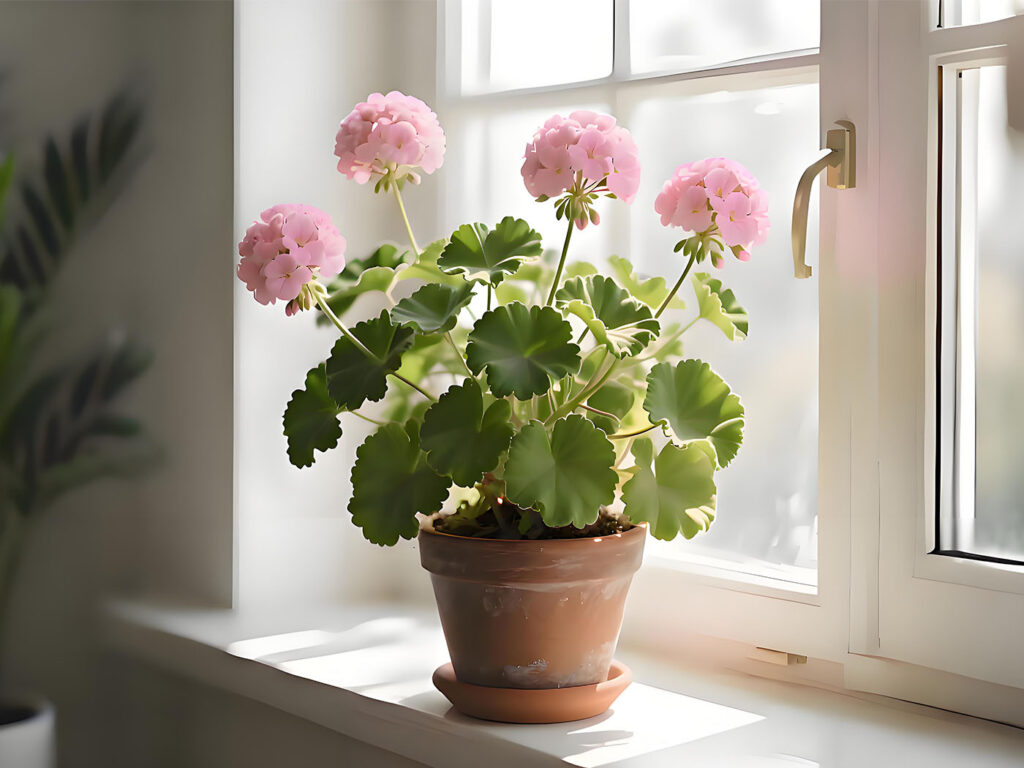Natural Pest Defense: The Matchstick Trick & Complete Geranium Care Guide
Tired of those annoying little gnats buzzing around your houseplants? Don’t worry! Skip the expensive chemical insecticides and avoid worries about harm to pets or family. Today, we’re sharing an incredibly simple, natural, harmless, and highly effective trick – the Matchstick Method! Plus, we’ll dive deep into caring for the beloved insect-repelling plant, Geraniums (Pelargoniums), so your home can be pest-free, vibrant, and fragrant.

一、The Magic Matchstick: Natural, Non-Toxic Gnat Control!
How it Works (Simple Science!): This method is surprisingly simple! The key lies in the sulfur and other compounds in the match head. When you insert an extinguished, cooled match head-down into damp potting soil, it slowly releases tiny amounts of sulfur compounds (like sulfur dioxide). This scent is barely noticeable to us but acts as a significant repellent to soil-dwelling pests like fungus gnats. It disrupts their environment, hindering larval development and preventing adults from laying eggs.
Step-by-Step (Super Simple!):
- Gather Supplies:A few ordinary matches (the wooden stick kind).
- Light & Extinguish:Light a match, let it burn for a few seconds, then blow out the flame. Ensure the match head is completely extinguished and cooled.
- Insert into Soil: Push the cooled matchhead-down vertically into the soil of the affected plant pot. We recommend 3-5 matches per small/medium pot. For larger pots, add more, spacing them evenly across the soil surface.
- Replace Regularly:The match head dissolves and loses effectiveness as the soil stays damp. Replace the matches every 5-7 days for best results. When the match head looks soft or dissolved, it’s time for a new one.
- Be Persistent: Breaking the gnat life cycle takes time.Consistent use for a few weeks will show a significant reduction, or even elimination, of those pesky gnats!
Why It’s Great:
Truly Natural & Safe: Contains no synthetic pesticides. Safe for kids, pets, beneficial insects (like bees!), and the environment.
Super Affordable: Ordinary matches cost next to nothing.
Effortless: No expertise needed. Done in a minute.
Proven Effective: Validated by countless plant enthusiasts, especially against soil-dwelling larvae (the source!).
Important Notes:
Crucial: Ensure matches are completely extinguished and cooled before inserting to avoid burning roots or fire risk.
Targets the Source: This method primarily disrupts larvae developing in the soil. While it can repel adult gnats, it doesn’t instantly kill flying adults. Pair it with yellow sticky traps for best adult control.
Severe Infestations: For very bad cases, you might also need to combine this with other methods like replacing the top layer of soil, improving air circulation, or adjusting your watering habits for complete eradication.

二、Your Natural Mosquito Guard: The Perfect Geranium Care Guide
Geraniums(especially scented varieties like Citronella Geraniums / Mosquito Plants – Pelargonium citrosum or P. graveolens) aren’t just pretty with their bright blooms. The unique scent released from their leaves (primarily citronellal, geraniol, etc.) is a natural insect repellent! A healthy geranium gives you beautiful flowers, lovely fragrance, and helps keep bugs away – killing two birds with one stone!
Geranium Care: Golden Rules
- Sunlight: The Power Source!
They Crave: Bright, direct sunlight! Minimum 4-6 hours of direct sun daily (6+ is ideal) for strong growth, abundant blooms, potent scent, and maximum repellency.
Location: South or West-facing windowsills, balconies, or patios are perfect.
Low Light Warning: Insufficient sun causes leggy growth, fewer flowers, yellowing leaves, weak scent, and poor pest-repelling power.
- Watering: Better Dry Than Soggy!
Key Rule: Geraniums hate wet feet! Always let the top 1-2 inches of soil dry out completely before watering again.
Method: Water thoroughly until it drains freely from the bottom. Always empty the saucer/drip tray afterward. Never let the pot sit in water.
Frequency: No fixed schedule! Adjust based on season (more in hot summers, less in cool winters), pot size, and your home’s humidity. Always check the soil first.
- Soil & Pots: Drainage is King!
Soil: Must be light, airy, and extremely well-draining. A good quality potting mix blended with perlite, coarse sand, or vermiculite (roughly a 3:1 ratio) works well. Avoid heavy garden soil or mixes that stay soggy.
Pots: Essential drainage holes! Terracotta or clay pots are excellent for breathability. Avoid pots that are too large for the plant – small plants in oversized pots hold too much moisture, risking root rot.
- Feeding: Little & Often for Blooms!
Growing Season (Spring/Summer/Fall): Feed every 1-2 weeks with a diluted, balanced liquid fertilizer (e.g., all-purpose plant food) or a high-phosphorus/potassium fertilizer (e.g., bloom booster, tomato feed). Follow label directions and err on the side of weaker solutions to prevent root burn.
Dormant Season (Winter): Stop fertilizing.
- Pruning & Pinching: For Bushiness & Continuous Flowers!
Pinching: Pinch off the growing tips of young plants to encourage bushier side growth.
Deadheading: Remove spent flower heads (and their stalks) promptly to encourage more blooms.
General Pruning: Regularly trim out leggy stems, weak growth, and dead or yellowing leaves. This improves air circulation and light penetration, reducing disease risk.
- Temperature & Overwintering:
Happy Range: 60°F – 75°F (15°C – 25°C).
Overwintering (Colder Zones): Most geraniums aren’t frost-hardy (damaged below 41°F/5°C). Bring them indoors before the first frost. Place in your sunniest spot, water very sparingly (just enough to prevent shriveling), and keep above 41°F/5°C. Ensure good air flow to avoid mold in humid indoor conditions.
- Pest & Disease Prevention:
Healthy plants in good conditions (sun, air, proper water) have few problems.
Watch For: Root rot (overwatering), Powdery mildew (poor air circulation), Aphids, Spider mites (dry, stagnant air).
Action: Isolate affected plants immediately. Remove badly damaged leaves. Treat with insecticidal soap, neem oil, or other safe remedies if needed.
Extra Repellency Tip: Gently rub the leaves of scented geraniums between your fingers to release more of their bug-repelling oils! Place pots near windows, doors, or sitting areas where bugs might enter or bother you.
Saying goodbye to annoying bugs can be this simple, natural, and budget-friendly! A few humble matchsticks can safeguard your potted plants. Combine this with a beautifully cared-for, naturally fragrant geranium, and your home environment will feel fresher, calmer, and full of vibrant life.
Try the Matchstick Trick today and give your geraniums some TLC! Enjoy a season filled with lovely blooms and sweet scents, free from buzzing pests!
